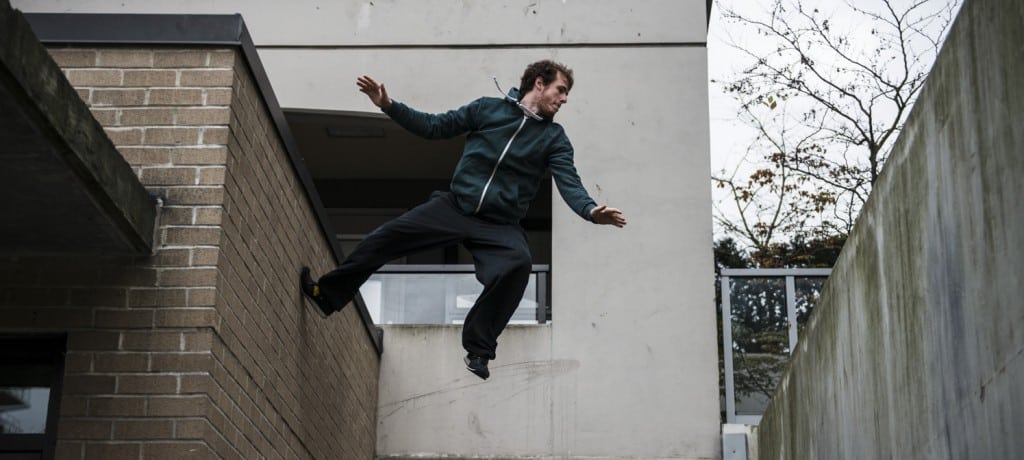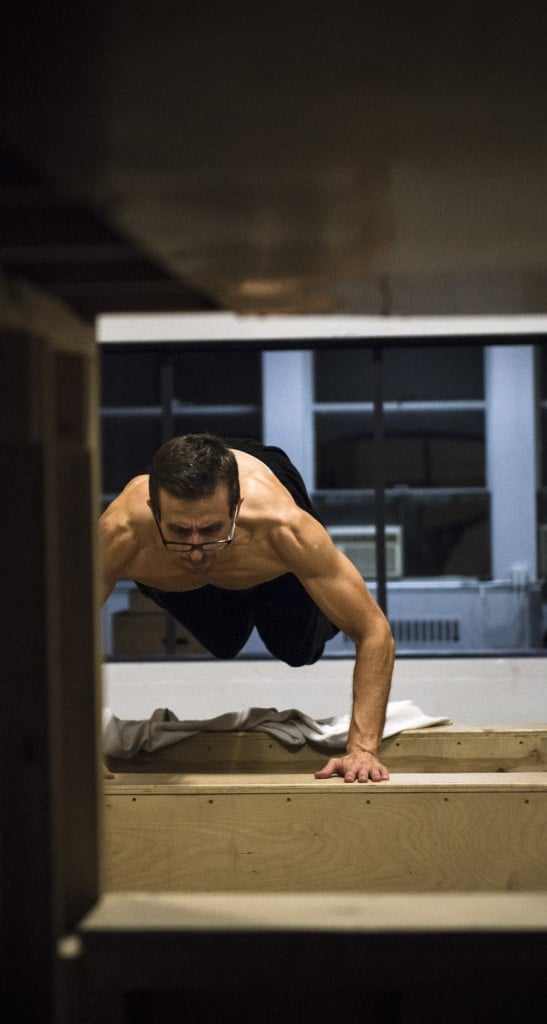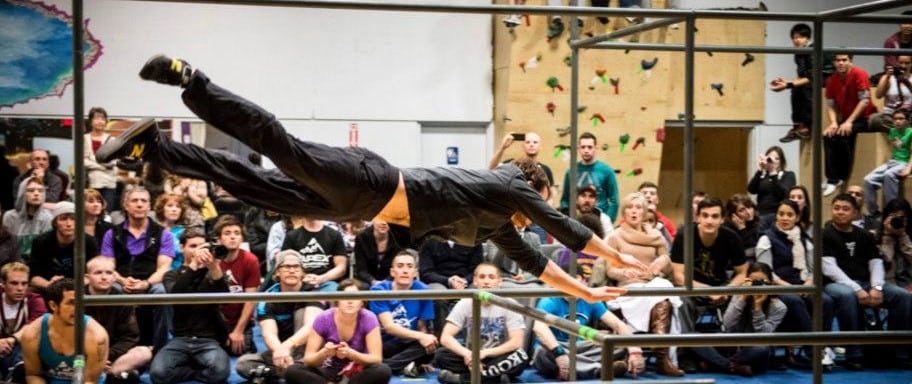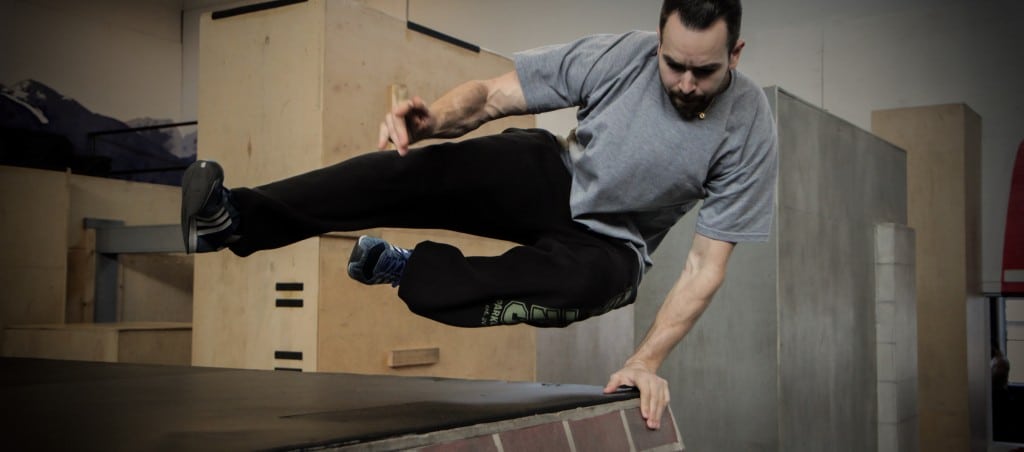The lack of organization for training by the majority, if not all parkour athletes, is an epidemic. Much of this can be attributed to the constant divide in parkour philosophies, which makes it difficult to determine training goals. The sport/culture is still very very young, but sport science is not, so there is no reason that an organized training plan can’t be developed. I write this from a sport perspective, but even if you do not view parkour as a sport you will still find the information applicable to your training.
Technical practices or “training sessions” are popularly defined by going out and finding the most relatively interesting or difficult jump, combo/line, flip, kong etc. to do and try it again and again until it is done (or not). When this is the majority of technical practice one cannot track progress or regulate recovery. As an athlete develops and becomes stronger, faster, and more explosive, recovery becomes more crucial for continued athletic improvement. In this series I will establish some guidelines for how to identify and organize training stresses to promote the most improvement while avoiding symptoms of overtraining.
Prelude:
Parkour: the art of seeking out Challenges…
Imagine you are at a new spot and you may be the first person in history to ever use it in the way you are about to. Completing this great jump (or thing) you are looking at will require a ton of physical, psychological, and emotional effort. To add to the psychological pressure you get a friend to film the action. Some passers-by stop and stare wondering what the heck you are doing standing up so high. “Is he going to jump?” You take your first attempt and don’t quite make it. You get up and try several more times until sure enough, this time, you land it. You repeat it a few times until you get every part clean. You feel a rush from the whole process. You feel happy. For a lot of athletes this is exactly what any given day out training is like, but what this also represents is highly specific and highly intensive stress. This instance and the stress it represents could be categorized as “competition intensity.” Finding new challenges and battling with the challenge until you complete it is an intense and competitive (with yourself) scenario.

Parkour practitioners thrive off of accomplishment. There is no better way to get that feeling of accomplishment than to go out and do something new and challenging. And so many athletes fill their weeks with several sessions where they explore and try to accomplish new things. If these types of sessions occur several times a week it means that the athlete is very frequently working at a high intensity with highly specific movements. The problem is that movement that are both highly intensive (movements performed with a high output) and highly specific (movements specific to parkour like jumping on ledges, vaulting, flipping, etc.) should be performed less frequently for the following reasons:
It lacks general physical preparation (GPP). Imagine a pyramid. At the top of the pyramid is specificity. Specificity consists of all competitive parkour movements applied to any variety of obstacles/structures. The middle of the pyramid is built up of all the means to develop specific skills. The base of the pyramid is GPP which consists of all general athletic qualities: Speed, Power, Strength, Balance, Coordination, Mobility, Stamina, and Suppleness. Like any pyramid, the wider the base, the higher the potential peak. So the more general qualities an athlete develops the easier it will be for the athlete to develop any number of specific athletic skills. Thus, a parkour athlete who spends all of their time working only on specific parkour movements will have limited potential for how high their peak can be.
Lacking a solid base of general qualities such as strength, balance, mobility, and suppleness will also leave an athlete predisposed to injury. Performing mostly specific movements develops a specific and unbalanced body. Performing these movements frequently with maximal outputs increases the likeliness of injury. When almost all of your training is highly intensive and highly specific, it is a ticking time bomb for chronic injury. Not to mention you are playing on the hardest of surfaces all the time: concrete.
It lacks measurable progress. If you want to know if you’re improving you really need to have specific goals that are trackable. Yes, you jumped a gap today that was 10 shoe lengths, and the last biggest gap you jumped was 9 and three quarter shoe lengths, and you did a stride mission the other day that you couldn’t do last week, so you must have increased your jump. Great, but that’s no way to measure consistency or incremental increases, both of which should be recorded regularly. Oh, by the way there is a perfectly good floor all around you that you can draw lines on and measure with a measuring tape instead of your shoes…
It lacks a long term plan. The plan is to go out and complete challenges. Maybe you do some strength training too and think that the strength training will make you jump farther and when you go back and try the challenge you’ll surely get it, because squats + frequent parkour jumpings = unlimited success. Sounds scientific! Not even hardly. If you program your lifting you need to program your technical training too! It’s ridiculous how many athletes are doing lifting programs, but don’t program their technical training or even factor in the potentially negative effects of adding max effort lifting stress to parkour stress. I’ve heard the words “Just do 5×5” too many times! Are you joking? There are no successful coaches of any sport telling their athletes to just increase their squat/bench/deadlift and then go do their technical work haphazardly. All stresses need to be considered and programmed carefully to obtain the best results.
I’ve had conversations with many advanced athletes, enthusiasts, and casual practitioners from all over the world about dealing with training stresses and motivation. What I’ve concluded is that too much training frequency under the typical high intensity/specificity circumstances is a recipe for eventual injury, unnecessary stress, frustration, anxiety, lack of motivation from a lack of noticeable gains, and many other reasons to drop off from parkour training. Yes, enjoying parkour too much can, ironically, make you eventually quit parkour.
Part 1. Identifying Intensity
In order to organize any training program, you must first identify and categorize the varying intensities of each training means. The intensity is determined not by which body part is being stressed, but by how much output is being produced. The output of various movements can be measured in the following ways…
Velocity: A stopwatch can be used to measure or monitor the output of a sprint or speed drill. A high intensity speed effort is categorized by how fast the athlete is moving relative to their Personal Best (PB). For example: an athlete with a 10m PB of 1.60s would need to run at least a 1.80s in order for the output to be considered maximal.
Distance or Height: A tape measurer can be used to measure or monitor the output of a jump.
*note that landing impact is considered intensive.
Tonnage: The amount of weight being moved can also be referred to as load. This measurement would be used for General Strength exercises like squats, deadlifts, and bench press. Total tonnage can also be considered as Load x Reps. The greater the amount of reps the more intensive the exercise becomes.
Intensive Training Stressors
Identifying intensive training stressors is crucial to begin mapping out a training plan. These types of activities should be performed on the same day or within the same session. The following day would be used for lower intensity training, active recovery, or complete rest depending on the goal of the training phase. A parkour athlete can consider the following to be intensive training stressors:
Training (Technical Practice)
Any practice session, jam, or outing is probably going to be considered high intensity. As I mentioned earlier, the average parkour session would have elements of “competition intensity”. As an athlete it’s important to have lower intensity practices, but as it is, most practices are haphazard and usually include maximal efforts. The following examples of intensive stressors will further illustrate this…

Sprints or Speed Lines
This would include sprints at over 90% intensity. It is important to note that speed intensity is decided by how close the athlete is to max velocity. It is unlikely that an athlete would reach max velocity performing a sequence of movements passing obstacles because the movements themselves would require the athlete to decelerate. The intensity of the movements, however, may or may not be considered an intensive training stressor.
Jumps
Maximum intensity jumps performed in any fashion. Once again, a speed run would be considered high intensity if maximal jumps are performed as one or more of the movements incorporated in the line.
*Note that impact is considered an intensive stressor. As a general rule, one could consider a drop of 3 ft or higher to be intensive.
Special Physical Preparation Exercises and Drills
SPP is a classification of exercises that mimic the speed, duration, and direction of movement of a competition activity, or in our case a parkour skill. An example of this type of exercise would be a high pull or dyno used to mimic the pull phase of a full climb up on a wall.
Primary Lifts
These exercises will vary from athlete to athlete and consist of variations of the squat, bench press, deadlift, clean, row, pull up, and dip. Loading any one of these exercises with 85%+ of a 1RM or performing the lift as a dynamic effort (lifting as fast as possible) are both considered intensive stressors. Performing as many reps as possible at any weight would also be considered an intensive stressor. It is best to have weight training sessions where no more than 2 of the lifts are intensive. Performing all of your exercises intensively would be like trying to improve too many qualities at once. Only the primary lift should be focused on. Other exercises can be used to improve the primary lift, however they should not be so intense that they take away from recovery.
Comparing Outputs
Once all intensive training means are identified we can begin to organize them in a program. It is important to note, as mentioned, the output is the speed, distance, tonnage, or velocity capable of being achieved in an activity by a particular athlete. Some exercises are more likely to have higher output than others. For example a single jump would have less output than a bound (plyo), because the later response jump would produce greater distance or height. An uninterrupted sprint would produce more velocity than a sprint of equal distance with a speed vault in the middle. Adding light resistance to an exercise can also limit the output like sprinting up a hill or performing a sled sprint.
Below is a progression of “parkour jumps” from least to greatest possible outputs. Popular terminology is in brackets.
Standing Broad Jump (Precision Jump) – Single Response Jump/Bound (Plyo) – Single Response Stride to Bound (Stride to Plyo) – Approach Bilateral Jump (Approach Plyo) – Running Jump (Running Precision)
In these examples the greater height x distance achieved with the jump is what determines the output. Response jumps (plyometric) produce greater ground contact forces and output capabilities than standing jumps. A variety of other movements such as vaults, tricks, tic tacs, and wall runs can be listed from least to greatest possible output depending on the force created by the preceding approach or response take off.
When designing a plan on any term it is best to build intensity by beginning with higher volume/lower outputs and progressing to lower volume/higher outputs. This concept is similar to progressive overload with weight training. One can also make adjustments to volume by considering the age and outputs capable of the athlete. Youth athletes are less trained and able to repeat higher outputs more frequently without trashing themselves. Athletes capable of greater outputs will require more rest and be less capable of repeating them as frequently. In the future installments of this series I will provide more information on how to progress intensities over a longer term.
Identifying Intensity is the most important tool in designing a training plan once the goals of the sport are established. Without understanding the intensities created by a variety of training means one can not factor in the necessary rest/recovery that is crucial for continued improvement. Remember that you do not improve speed, power, or strength during a training session. Improvements are made by recovering and adapting to the training stimulus.
References:
(1) Smith, James (2011) Club Sports Conundrum Pt. I
http://powerdevelopmentinc.com/wp-content/uploads/2011/02/Club-Sports-Conundrum.pdf
(2) Smith, James (2011) Club Sports Conundrum Pt. II
http://powerdevelopmentinc.com/wp-content/uploads/2011/02/Club-Sports-Conundrum-Part-II.pdf
(3) Smith, W. Chad (2012) Consolidation of Stressors
http://www.jtsstrength.com/articles/2012/04/13/consolidation-of-stressors/



